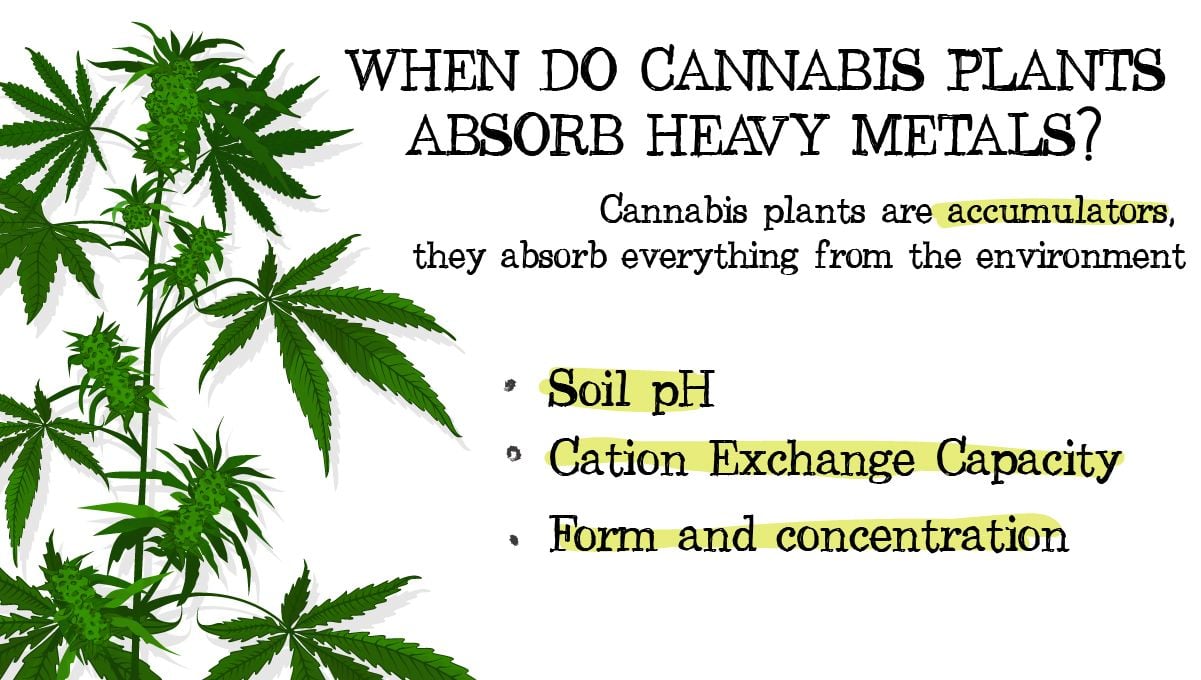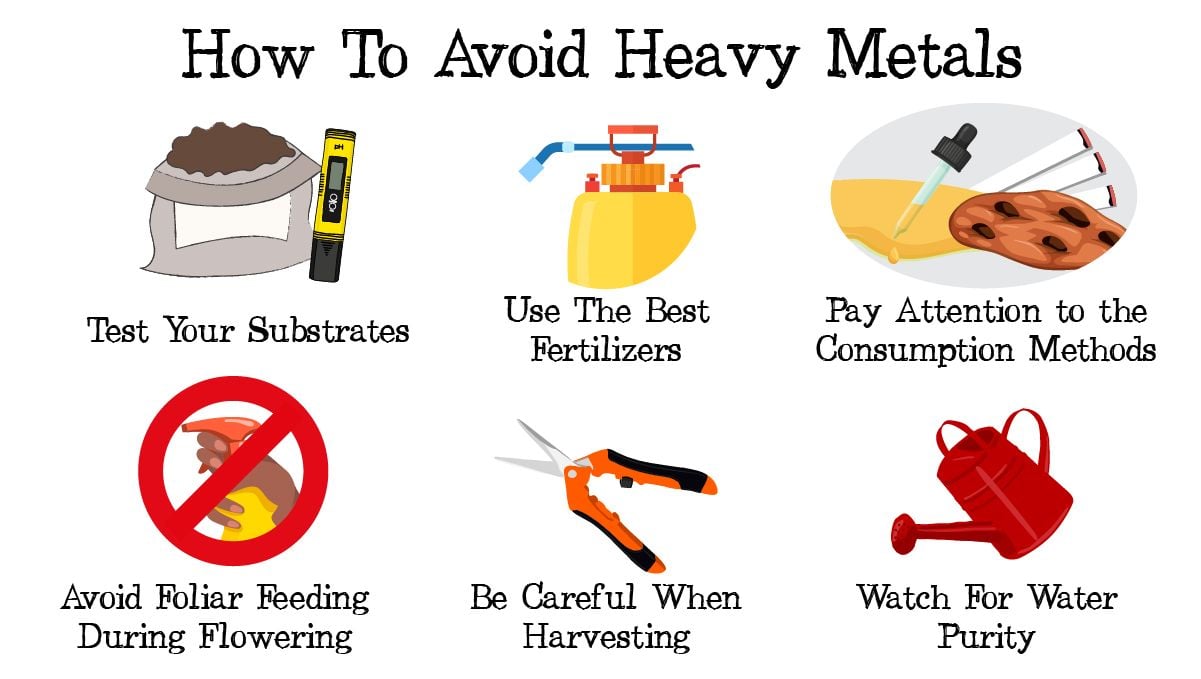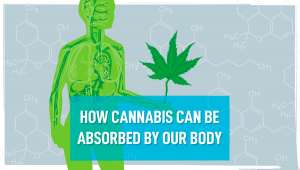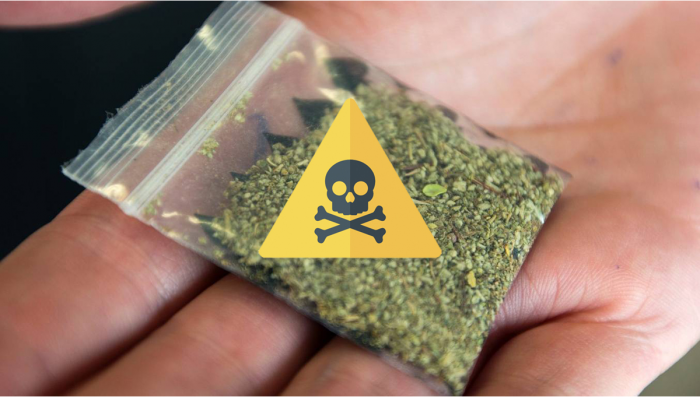The Dangers of Heavy Metals In Cannabis Products

- 1. What are heavy metals?
- 2. Where do heavy metals come from?
- 2. a. Heavy metals in other cannabis products
- 3. Can cannabis plants accumulate heavy metals?
- 3. a. Soil ph and cation exchange capacity
- 3. b. Heavy metal forms and concentrations
- 3. c. Heavy metal absorption
- 4. How to test for heavy metals?
- 5. Risks of consuming heavy metals
- 6. Top tips to avoid heavy metals
- 7. In conclusion
Feminized seeds absorb nutrients from the soil and environment through their roots in order to grow and sometimes the soil may contain heavy metals which can be toxic. Now, not all metals are bad for plants and humans, metals like zinc, manganese, and iron are essential plant nutrients, but other metals such as lead, cadmium, and mercury can affect plant growth and pose a risk to consumers.
1. What Are Heavy Metals?
Heavy metals are elements with high densities, high atomic weights, or high atomic numbers, and can be toxic to humans and plants if ingested in high quantities. These elements occur naturally in soil but can also enter the soil or growing substrate through external sources. Just remember that, as mentioned, cannabis plants need metals in order to grow, just not the detrimental type, this means that there are several types of metals but the toxic ones are the heavy metals.
Before we delve into the type of heavy metals and if cannabis plants accumulate them, it’ll help to learn more about these substances. These metallic chemical elements possess a high atomic weight and density, hence their name. While some heavy metals do occur naturally in the environment, they can occur at unnaturally high levels in some areas as a pollutant because of industrial processes such as mining. The most common heavy metals include lead, mercury, arsenic, and chromium. These metals are viewed as toxic because they have the tendency to accumulate in the body over time, causing harmful effects. Despite this concern, some heavy metals actually play a rather fundamental role in the processes of the natural world. Some are involved in nutrient cycling. For example, iron and copper are used by enzymes to function. Furthermore, some heavy metals also help plants to defend against pathogens and conduct redox reactions.
Essential Metals For Cannabis
These metals are essential plant nutrients that cannabis plants need and are toxic but only when consumed in extremely large amounts.
- Zinc
- Manganese
- Iron
- Copper
- Nickel

Detrimental Metals For Cannabis
These metals are toxic to plants and humans and you should avoid them due to being extremely toxic in relatively low concentrations.
- Lead
- Cadmium
- Chromium
- Arsenic
- Mercury
- Arsenic
2. Where Do Heavy Metals Come From?
As mentioned, these metals are naturally found in soil but high concentrations of heavy metals are caused by external sources, often, companies dispose of chemicals and other agricultural pollutants that increase these elements’ levels, thus becoming toxic. Apart from wastes, chemical fertilizers and pesticides that are high in phosphates can also be a source of heavy metals, which can contaminate the soil and water. This happens because many products may contain contaminants due to the raw materials used to produce them, many companies use ingredients of a lower quality to be able to sell their products at a lower cost but this results in the products often carrying heavy metals that can contaminate cannabis plants, the soil, and water.
Heavy metals may also end up in the environment via mining. Typically, this is exactly how high levels of gold, silver, copper, and zinc end up in the soil and water. These metals have the tendency to leach into rivers, causing contamination and harming important aquatic species. Heavy metals can also work their way into the wider environment through a process known as atmospheric deposition. Smelting, power generation, and transportation, unfortunately, push these substances into the air, where they’re forced around by the wind and eventually land on soils. As soon as heavy metals are dispersed into the natural environment, they accumulate in the food chain. After landing in the soil, they end up in plants. Both livestock and humans consume the plants, which can lead to ill health effects at some point down the line.
Heavy Metals in other cannabis products
Keep in mind that contaminated flower isn’t the only way you can consume heavy metals in cannabis products. Depending on your preferred consumption method, the cannabis product itself may be clean but the consumption method may be contaminating it. This means that you should not only know the quality of your cannabis flowers but also the quality of the vaporizer or consumption method you’re using. So always buy your bongs, vaporizers, and even rolling papers from trustable vendors. For example, some vaporizer cartridges contain a metal core that heats up, vaporizing the cannabis product. When this happens, heavy metals can leach from the metal core and coil, getting carried through the vapor and ending up in your lungs and body. So always make sure to buy your cannabis or cannabis products from trustworthy legal dispensaries as all their products go through lab testing and very strict standards.
If you don’t have access to legal cannabis products and are getting your cannabis from the black market, you should consider growing your own because this is a great way to know exactly what you’re consuming as you’re responsible for watering, feeding, and harvesting your plants. Growing cannabis isn’t extremely difficult but it takes a couple of grow cycles for you to get the hang of it, having said that, once you understand what you have to do you’ll get an everlasting supply of the best quality weed for a fraction of the price, so if you’re dealing with low-quality weed do not risk it, remember, you should not consume contaminated weed and there are several ways for you to get your hands on clean weed, which is extremely important, especially if you’re a medical patient.
3. Can Cannabis Plants Accumulate Heavy Metals?
The cannabis plant is unique because it’s an accumulator plant, meaning that it absorbs everything from the environment. Commercial growers especially should be concerned with heavy metals in the soil because the roots can absorb them and it will end up in the final product. Now, the presence of detrimental heavy metals in the soil or growing substrate, water, or fertilizers does not mean that the cannabis plant will absorb them because it depends on the element and soil conditions. However, under certain conditions, they can be absorbed and accumulated in the cannabis plant. This happens because heavy metals are usually immobile so they need to be ionic in order for the cannabis plant to absorb them; Also, the pH of the soil affects the absorption and accumulation of heavy metals because most metals are accumulated when the pH level of the soil is low. So no, your plant won’t always absorb heavy metals, but it will under the right conditions.
Away from soil conditions, several other factors can also affect the absorption of heavy metals by your cannabis plants. Both the age and vitality of a plant can influence its tendency to take up heavy metals from the soil. Younger plants, such as those in the early vegetative phase of the growing cycle, are more receptive to heavy metals than older plants that are well into the flowering phase. Plants that are undergoing high levels of biotic and abiotic stress are also more likely to absorb heavy metals from the surrounding soil. An array of environmental factors also come into play, including light exposure, temperature, and humidity. Being aware of these can help you to protect your plants, and yourself, from exposure to these substances.
Soil pH and Cation Exchange Capacity
The soil pH and Cation Exchange Capacity play a major role in whether heavy metals can be absorbed by a cannabis plant. As mentioned before, the availability of most heavy metals increases as the pH of the soil decreases, the only exceptions are arsenic and mercury which are more available when the pH increases. Cation Exchange Capacity defines the ability of soil or a certain substrate to hold positively charged ions, this is measured because most heavy metals are positively charged so, as the CEC increases, the substrate holds on to heavy metals, decreasing its availability to cannabis plants.

Heavy Metal Forms and Concentrations
Most heavy metals tend to be immobile but this can depend on the metal and the form it presents in. For example, chromium in Cr (III) version is the form preferred by cannabis plants but it’s less mobile than Cr (VI) which is the most harmful to humans. This means that even if heavy metals are detected in the soil, the ability to get into your cannabis plants can be very low, depending on the form and pH of the soil but also the concentration of the element in the soil. This happens because, in low concentrations, cannabis plants won’t absorb a significant amount and won’t have a harmful effect, although ideally, the heavy metal concentration in your cannabis should be zero.
Heavy Metal Absorption
Now, if the soil conditions (including pH), the metal is in the right form and the concentration is high, your plants will end up absorbing heavy metals. Studies have indicated that when heavy metals are absorbed by cannabis plants, the majority accumulates in the roots and leaves while the minority tends to accumulate in the flowers.
4. How To Test For Heavy Metals?
Specialized laboratories can test for heavy metals through a couple of tests such as inductively coupled plasma mass spectrometry, inductive plasma optical emission spectroscopy, and atomic absorption spectroscopy, which all detect trace amounts of heavy metals. These tests can detect the concentration of heavy metals in flowers, edibles, topicals, and all other types of cannabis products, with the maximum limit allowed being the following:
Maximum Limit Allowed of Heavy Metals In Cannabis Products
| Heavy Metal | Maximum Limit Allowed | ||
|---|---|---|---|
| Flowers | Edibles | Topicals | |
| Mercury | 0.1 μg/g | 3.0 μg/g | 1.0 μg/g |
| Arsenic | 0.2 μg/g | 1.5 μg/g | 3.0 μg/g |
| Lead | 0.5 μg/g | 0.5 μg/g | 10.0 μg/g |
| Cadmium | 0.2 μg/g | 0.5 μg/g | 5.0 μg/g |
5. Risks of Consuming Heavy Metals
Depending on the concentrations, heavy metals can have a wide range of effects on humans; From headaches and nausea to organ failure and cancer in cases of prolonged exposure, also, in cases where cannabis has been smoked, it can increase the chances of respiratory conditions.

This happens because heavy metals can mimic other essential elements and replace them in the bones and cells, binding to sites where they weren’t supposed to bind to; This ends up causing malfunctioning of the cells and heavy metal toxicity, also, heavy metals can cause antioxidant homeostasis which causes further damage. Amongst all the heavy metals, the elements that have been more recurrent in hospitals are the following:
- Mercury may cause neurological damage;
- Lead can cause gastrointestinal problems, joint and muscle pain, and dizziness;
- Arsenic is carcinogenic and highly toxic;
- Cadmium has the potential to cause cancer.
6. Top Tips To Avoid Heavy Metals
Now that you know everything you need to know about heavy metals and cannabis, here are a couple of tips to help you avoid heavy metals in your cannabis flower and cannabis products.
Test your substrate
Test your soil and substrate throughout the grow cycle for the presence of heavy metals.
Use the best fertilizers possible
Use fertilizers made from high purity ingredients.
Water purity is important
Use filtered water to avoid contamination from heavy metals that can be found in tap water.

Be careful when harvesting
Be careful during trimming and drying because stainless steel scissors or harvesting machines may contain lead, nickel, and chromium and can end up in your final product.
Pay attention to your consumption methods
Recent research has found trace metals in rolling papers so make sure you use good quality papers and avoid metal pipes and bongs.
Avoid foliar sprays during flowering
Avoid foliar spraying during flowering unless you are 100% sure it doesn’t contain heavy metals.
7. In Conclusion
Heavy metals can be highly toxic if consumed for a long time and in high concentrations so it’s vital to test your substrate and use good quality fertilizers when possible. Heavy metals don’t actually present a threat in small concentrations but if you’re an avid smoker, make sure to avoid them.
If you have more tips on how to avoid heavy metals in cannabis plants, feel free to share them with fellow growers by leaving a comment in the comment section below!















Comments